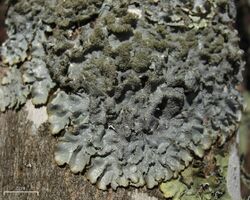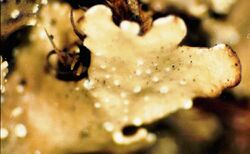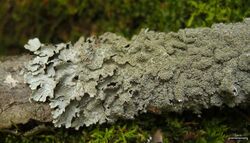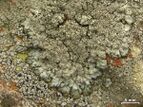Biology:Punctelia rudecta
| Punctelia rudecta | |
|---|---|

| |
| In Cataloochee (Great Smoky Mountains), North Carolina; growing on the upper trunk of a red maple tree | |
| Scientific classification | |
| Domain: | Eukaryota |
| Kingdom: | Fungi |
| Division: | Ascomycota |
| Class: | Lecanoromycetes |
| Order: | Lecanorales |
| Family: | Parmeliaceae |
| Genus: | Punctelia |
| Species: | P. rudecta
|
| Binomial name | |
| Punctelia rudecta (Ach.) Krog (1982)
| |
| Synonyms[1] | |
| |
Punctelia rudecta, commonly known as the rough speckled shield or the speckleback lichen, is a North American species of foliose lichen in the family Parmeliaceae. This species can be readily identified by the light color of the thallus underside, the relatively large lobes at the edges of the thallus, and the tiny white pores present on the top of the thallus that are characteristic of the genus Punctelia. The lichen is quite abundant and widespread in the eastern and southeastern United States, although it also occurs in Canada and northern Mexico, but is less common in these regions. The lichen usually grows on bark, and less commonly on shaded rocks. There are several lookalike Punctelia species; these can often be distinguished from P. rudecta by differences in distribution or in the nature of the reproductive structures present on the thallus.
Although Punctelia rudecta was previously thought to have a much more expansive global distribution, phylogenetic analysis revealed a species complex that has subsequently been split into four distinct cryptic lineages with more restricted distributional ranges. Punctelia rudecta is moderately sensitive to air pollution and has been assessed as a suitable candidate for biomonitoring air quality.
Systematics
Swedish lichenologist Erik Acharius described the lichen as a new species in 1814 as Parmelia rudecta.[2] The type specimen was collected by American clergyman and botanist Gotthilf Heinrich Ernst Muhlenberg.[3] Historically, Edward Tuckerman thought that the taxon was better suited as a variety of Parmelia borreri,[4] while Bruce Fink suggested that it should be a subspecies of that taxon.[1] In 1902, Antonio Jatta proposed a transfer to genus Imbricaria;[5] this genus name is no longer used for lichens and is considered a synonym of Anaptychia.[6] In a 1962 study of specimens named as Parmelia ruderata from Japan, William Culberson proposed that it be placed in synonymy with P. rudecta,[7] but this was not accepted by later workers and DNA evidence has since shown that Punctelia ruderata is an independent species.[8] In 1982, Hildur Krog circumscribed the genus Punctelia to contain Parmelia species with rounded pseudocyphellae, and P. rudecta was one of the 22 species transferred to the new genus.[9]
Parmelia rudecta is known colloquially as the "rough speckled shield"[10][11] or the "speckleback lichen".[12] It has also been called the "backyard buddy", alluding to the relatively high chance of finding this lichen in a backyard in the eastern United States.[13]
Phylogeny
A 2004 molecular phylogenetic study of Punctelia species in the Iberian Peninsula suggested that the taxon Parmelia rudecta did not form a monophyletic grouping, indicating that more than one species was being represented by the taxon.[14] This interpretation was later corroborated in a large-scale phylogenetic study of the family Parmeliaceae that was published in 2010.[15] A 2016 followup study of P. rudecta specimens from collections around the world confirmed the suspected cryptic diversity: there were four morphologically similar, but geographically isolated species that were all being called Parmelia rudecta. Three of these species were epitypified (P. rudecta in the strict sense, P. toxodes and P. ruderata), and a fourth, P. guanchica, was described as a new species. Because the original type specimen of P. rudecta was collected in North America, this name was kept for the North American species. The epitype used in the 2016 study was collected in Great Smoky Mountains National Park, North Carolina.[8]
Description

The thallus of Punctelia rudecta ranges in color from dark greenish-gray to almost blue-gray;[10] it tends to be more gray-greenish when fresh, and more brown-yellowish when dry.[16] The thallus has a relatively tight attachment to its substrate. The lobes comprising the thallus are mostly 3–8 mm (0.1–0.3 in) wide, and are more or less covered with cylindrical to branched isidia;[10] the isidia are typically more numerous towards the center of the thallus.[11] Sometimes the isidia can become so dense that they form mounds, obscuring the lobes underneath. Both the margins of the lobes and the tips of the isidia have a brown tinge.[17] The lichen, when it has a bluish-green coloration and dense isidia, can be readily spotted from a distance.[11] White pseudocyphellae are usually prominent on the tips of the lobes.[10] The lower surface of the thallus is tan, with pale rhizines. Apothecia are uncommon.[10] If present, they are up to 4 mm (0.16 in) in diameter, with a brown hymenium and thin margin rolled inward. The ascospores measure 12.8–16 by 8–9.6 μm, and are ellipsoid in shape. They lack septa, and are smooth, thin-walled, and hyaline.[16] The photobiont partner is the green alga species Trebouxia anticipata.[18]
Standard chemical tests can be used to help identify Punctelia rudecta. In the medulla, these results are PD-, K-, KC+ red, and C+ red. The last of these tests indicates the presence of lecanoric acid.[10] The cortex contains atranorin, which results in a yellow K+ reaction.[11]
Similar species
Punctelia rudecta is a member of a complex of several morphologically similar but geographically separated species. P. ruderata occurs in Asia and East Africa. P. guanchica, known only from the Canary Islands, grows on volcanic rocks. The South African member of the complex, Punctelia toxodes, grows on both tree bark and rocks.[8]
Punctelia eganii, known from a single locality in Alabama, USA, was described as a new species in 2011. Although morphologically identical to P. rudecta, it produces lichexanthone, a secondary compound previously unknown in Punctelia. This compound, which is present only in its pseudocyphellae, causes these structures to fluoresce when viewed under ultraviolet light and allow these otherwise identical species to be distinguished from each other. Two other similar species are P. missouriensis and P. punctilla; these species are distinguished from P. rudecta by their propagules: they both produce ecorticate (without a cortex), scale-like soredia, structures that can be mistaken for isidia.[19] Specimens of P. rudecta that have few isidia can be mistaken for the southwestern speckled shield lichen, P. hypoleucites. This relatively rare species has a range restricted to Texas and Mexico.[10]
Habitat and distribution
Punctelia rudecta has a temperate distribution in North America.[11] Although the range maps included in some popular North American lichen field guides suggest that it does not occur in the tropical climate of southern Florida,[10][13] it was recorded in Fakahatchee Strand Preserve State Park in 2011.[20] It is occasionally recorded from western North America, but it is much less frequently encountered there.[17][21] It grows on bark of all kinds, or on shaded rocks. Irwin Brodo calls it "one of the most common eastern isidiate foliose lichens",[10] while Erin Tripp and James Lendemer express similar sentiments about its prevalence, describing it as "arguably the weediest macrolichen east of the Mississippi River". In its range it grows in all types of forests, and at all elevations.[13] The lichen occurs in most Canadian provinces (Manitoba, New Brunswick, Nova Scotia, Ontario, Prince Edward Island, Quebec, and Saskatchewan). It has a national conservation status of "secure", and is "secure" or "apparently secure" in all provinces except Saskatchewan, where its status is "critically imperiled".[12] In Mexico, it has been reported from the Distrito Federal, Chiapas, Veracruz, Jalisco,[16] Baja California, Chihuahua, Durango and Sonora.[17]
Ecology

Punctelia rudecta has an annual radial (i.e., expanding outward from the center) growth rate of about 5 mm (0.2 in) per year, similar to other foliose lichens in the family Parmeliaceae.[22] Ovicuculispora parmeliae (previously known as Nectria parmeliae) is a lichenicolous fungus that uses Punctelia rudecta as one of its many hosts.[23][24] Laboratory studies established that this fungus is incapable of growing on Punctelia rudecta unless phenolic defense compounds are first removed from the lichen. In nature, O. parmeliae can grow on P. rudecta only after another lichen inhabitant, an epiphytic species of Fusarium, first enzymatically degrades lecanoric acid, the primary lichen compound of P. rudecta. Field studies demonstrated that lichens harboring N. parmeliae generally also harbor the Fusarium species.[24] Other fungal parasites that have been recorded growing on P. rudecta include Trichosphaerella buckii, Pronectria subimperspicua,[25] and an unidentified species of Cladophialophora.[26]
A study conducted in New York showed that Punctelia rudecta provides shelter for several species of mites; Carabodes higginsi, Phauloppia banksi, and an undetermined species of Anachipteria were the most numerous species encountered. The mites may help with the dispersal of lichen spores.[27]
Biomonitoring studies
Based on the frequency of Punctelia rudecta in heavily polluted areas, it is considered a relatively pollution-tolerant species,[28] although it is sensitive to ambient sulfur dioxide (SO2), and will not grow unless airborne SO2 concentrations are low.[29] It has been investigated for its potential use as an indicator of air quality in biomonitoring programs. To do this, the lichen is studied for effects on growth and for the accumulation of pollutants (such as toxic heavy metals) in the thallus, which, after collecting samples, can be determined in the laboratory with chemical techniques.[30][31][32] Punctelia rudecta is recommended for use as a biomonitor in the cooler forested uplands of Alabama, Georgia, North Carolina and South Carolina.[33]
Human uses
Punctelia rudecta can be used to create a dye by a color-extraction with ammonia as a solvent. A pink color is obtained using this method.[34]
References
- ↑ 1.0 1.1 "Synonymy: Punctelia rudecta (Ach.) Krog". Species Fungorum. http://www.speciesfungorum.org/Names/SynSpecies.asp?RecordID=110980.
- ↑ Acharius, E. (1814) (in la). Synopsis Methodica Lichenum. p. 197. https://books.google.com/books?id=J7o_AAAAcAAJ&pg=PA197.
- ↑ Hale, Mason E. (1965). "Studies on the Parmelia borreri group". Svensk Botanisk Tidskrift 59: 37–48. http://www.diva-portal.org/smash/get/diva2:1202272/FULLTEXT01.pdf.
- ↑ Tuckerman, E. (1845). An Enumeration of North American Lichens with a preliminary view of the structure and general history of these plants, and of the Friesian system. Cambridge: J. Owen. p. 49. https://www.biodiversitylibrary.org/page/23859839.
- ↑ Jatta, A. (1902). "Licheni cinesi raccolti allo Shen-si negli anni 1894–1898 dal rev. Padre Missionario G. Giraldi" (in it). Nuovo Giornale Botanico Italiano 9 (4): 460–481. https://bibdigital.rjb.csic.es/viewer/12810/?offset=#page=473&viewer=picture&o=bookmark&n=0&q=.
- ↑ "Synonymy: Anaptychia Körb.". Species Fungorum. http://www.speciesfungorum.org/Names/SynSpecies.asp?RecordID=186.
- ↑ Culberson, W. L. (1962). "Some pseudocyphellate Parmeliae". Nova Hedwigia 4: 563–577.
- ↑ 8.0 8.1 8.2 Wong, William Oki; Alors, David; Lumbsch, H. Thorsten; Divakar, Pradeep K.; Leavitt, Steven D.; Crespo, Ana (2016). "An integrative approach for understanding diversity in the Punctelia rudecta species complex (Parmeliaceae, Ascomycota)". PLOS ONE 11 (2): e0146537. doi:10.1371/journal.pone.0146537. PMID 26863231. Bibcode: 2016PLoSO..1146537A.
- ↑ Krog, Hildur (1982). "Punctelia, a new lichen genus in the Parmeliaceae". Nordic Journal of Botany 2 (3): 287–292. doi:10.1111/j.1756-1051.1982.tb01191.x.
- ↑ 10.0 10.1 10.2 10.3 10.4 10.5 10.6 10.7 10.8 Brodo, Irwin M.; Sharnoff, Sylvia Duran; Sharnoff, Stephen (2001). Lichens of North America. New Haven: Yale University Press. p. 608. ISBN 978-0-300-08249-4.
- ↑ 11.0 11.1 11.2 11.3 11.4 Hinds, James W.; Hinds, Patricia L. (2007). The Macrolichens of New England. Memoirs of the New York Botanical Garden. 96. Bronx, New York: New York Botanical Garden Press. pp. 431–432. ISBN 978-0-89327-477-1.
- ↑ 12.0 12.1 "Punctelia rudecta. Rough Speckled Shield Lichen". NatureServe Explorer 2.0. https://explorer.natureserve.org/Taxon/ELEMENT_GLOBAL.2.124383/Punctelia_rudecta.
- ↑ 13.0 13.1 13.2 Tripp, Erin A.; Lendemer, James C. (2020). Field Guide to the Lichens of Great Smoky Mountains National Park. Knoxville: The University of Tennessee Press. pp. 390–391. ISBN 978-1-62190-514-1.
- ↑ Crespo, Ana; Divakar, Pradeep K.; Argüello, Arturo; Gasca, Concepción; Hawksworth, David L. (2004). "Molecular studies on Punctelia species of the Iberian Peninsula, with an emphasis on specimens newly colonizing Madrid". The Lichenologist 36 (5): 299–308. doi:10.1017/S0024282904014434. https://www.researchgate.net/publication/231937615.
- ↑ Crespo, Ana; Kauff, Frank; Divakar, Pradeep K.; del Prado, Ruth; Pérez-Ortega, Sergio; de Paz, Guillermo Amo et al. (2010). "Phylogenetic generic classification of parmelioid lichens (Parmeliaceae, Ascomycota) based on molecular, morphological and chemical evidence". Taxon 59 (6): 1735–1753. doi:10.1002/tax.596008. https://www.researchgate.net/publication/233528761.
- ↑ 16.0 16.1 16.2 Álvarez, Isela (2009). "Flavopunctelia y Punctelia (Ascomycetes liquenizados) de Nueva Galicia, México" (in es). Revista Mexicana de Micología 29. http://www.scielo.org.mx/scielo.php?pid=S0187-31802009000100004&script=sci_arttext.
- ↑ 17.0 17.1 17.2 Lichen Flora of the Greater Sonoran Desert Region. 2. Tempe: Arizona State University. 2004. pp. 435–436. ISBN 978-0-9716759-1-9. http://lichenportal.org/portal/taxa/index.php?taxon=54749.
- ↑ Bubrick, Paul (1988). "Methods for cultivating lichens and isolated bionts". CRC Handbook of Lichenology. III. Boca Raton: CRC Press. p. 134. ISBN 978-0-8493-3583-9.
- ↑ Hodkinson, Brendan P.; Lendemer, James C. (2011). "Punctelia eganii, a new species in the P. rudecta group with a novel secondary compound for the genus". Opuscula Philolichenum 9: 35–38. https://www.researchgate.net/publication/265155405.
- ↑ Lücking, Robert; Seavey, Frederick; Common, Ralph S.; Beeching, Sean Q.; Breuss, Othmar; Buck, William R. et al. (2011). "The lichens of Fakahatchee Strand Preserve State Park, Florida: Proceedings from the 18th Tuckerman Workshop". Bulletin of the Florida Museum of Natural History 46 (4): 127–186. https://www.fs.fed.us/global/iitf/pubs/ja_iitf_2011_Lucking001.pdf.

- ↑ McCune, Bruce; Geiser, Linda (1997). Macrolichens of the Pacific Northwest. Corvallis: Oregon State University Press. p. 299. ISBN 978-0-87071-394-1.
- ↑ Lawrey, James D.; Hale, Mason E. Jr. (1977). "Natural history of Plummers Island, Maryland XXIII. Studies on lichen growth rate at Plummers Island, Maryland". Proceedings of the Biological Society of Washington 90: 698–725. https://www.biodiversitylibrary.org/page/39058458.
- ↑ Lawrey, James D.; Rossman, Amy Y.; Lowen, Rosalind (1994). "Inhibition of selected hypocrealean fungi by lichen secondary metabolites". Mycologia 86 (4): 502–506. doi:10.1080/00275514.1994.12026442.
- ↑ 24.0 24.1 Lawrey, James D. (2000). "Chemical interactions between two lichen-degrading fungi". Journal of Chemical Ecology 26 (8): 1821–1831. doi:10.1023/A:1005540622612.
- ↑ Lendemer, James C.; Harris, Richard C.; Ruiz, Ana Maria (2016). "A review of the lichens of the Dare regional biodiversity hotspot in the mid-Atlantic coastal plain of North Carolina, eastern North America". Castanea 81 (1): 1–77. doi:10.2179/15-073R2.
- ↑ England, J. Kevin; Hansen, Curtis J.; Allen, Jessica L.; Beeching, Sean Q.; Buck, William R.; Charny, Vitaly et al. (2019). "Checklist of the lichens and allied fungi of Kathy Stiles Freeland Bibb County Glades Preserve, Alabama, USA". Opuscula Philolichenum 18: 420–434. https://www.researchgate.net/publication/337679790.
- ↑ Root, Heather T.; McGee, Gregory G.; Norton, Roy A. (2007). "Arboreal mite communities on epiphytic lichens of the Adirondack Mountains of New York". Northeastern Naturalist 14 (3): 425–438. doi:10.1656/1092-6194(2007)14[425:AMCOEL2.0.CO;2]. https://www.researchgate.net/publication/232694005.
- ↑ Perlmutter, Gary B. (2010). "Bioassessing air pollution effects with epiphytic lichens in Raleigh, North Carolina, U.S.A.". The Bryologist 113 (1): 39–50. doi:10.1639/0007-2745-113.1.39.
- ↑ Showman, Ray E. (1990). "Lichen recolonization in the upper Ohio River Valley". The Bryologist 93 (4): 427–428. doi:10.2307/3243607.
- ↑ McClenahen, James R.; Davis, Donald D.; Hutnik, Russell J. (2007). "Macrolichens as biomonitors of air-quality change in western Pennsylvania". Northeastern Naturalist 14 (1): 15–26. doi:10.1656/1092-6194(2007)14[15:MABOAC2.0.CO;2].
- ↑ Will-Wolf, Susan; Makholm, Martha M.; Nelsen, Matthew P.; Trest, Marie T.; Reis, Anne H.; Jovan, Sarah (2015). "Element analysis of two common macrolichens supports bioindication of air pollution and lichen response in rural midwestern U.S.A". The Bryologist 118 (4): 371–384. doi:10.1639/0007-2745-118.4.371.
- ↑ Will-Wolf, Susan; Jovan, Sarah; Amacher, Michael C. (2017). "Lichen elements as pollution indicators: evaluation of methods for large monitoring programmes". The Lichenologist 49 (4): 415–424. doi:10.1017/S0024282917000299. https://www.fs.fed.us/pnw/pubs/journals/pnw_2017_will-wolf001.pdf.
- ↑ Will-Wolf, Susan; Jovan, Sarah (2019). "Lichen species as element bioindicators for air pollution in the eastern United States of America". Plant and Fungal Systematics 64 (2): 137–147. doi:10.2478/pfs-2019-0015. https://www.researchgate.net/publication/337985071.
- ↑ Diadick Casselman, Karen (2011). Lichen Dyes. The New Source Book (2nd ed.). Mineola, New York. p. 33. ISBN 978-0-486-41231-3.
Wikidata ☰ Q21312515 entry
 |



